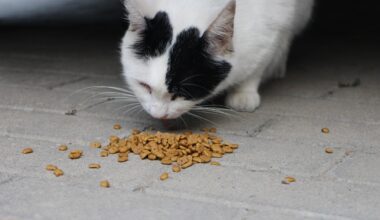Understanding Anxiety in Cats: Symptoms and Solutions
Anxiety is a common issue among cats, manifesting in various forms. Unlike dogs, cats may display anxiety through subtle behavioral changes. Symptoms of anxiety can include excessive grooming, withdrawal from social interactions, aggression, or inappropriate elimination. Understanding these signs is crucial for cat owners to support their feline companions effectively. Anxiety can arise from multiple causes such as environmental changes, traumatic experiences, or even genetic predispositions. Identifying the root cause of anxiety is critical for effective treatment. Providing a safe and secure environment is vital for any cat that exhibits signs of anxiety. Cats thrive on routine, so changes in their environment can lead to increased stress. Ensure your cat has a designated safe space where it can retreat when feeling anxious. Moreover, enriching their environment with toys and interaction can help alleviate anxiety symptoms. It’s also important to consult a veterinarian to discern if the anxiety stems from a medical issue requiring attention. For long-term management, consider behavioral therapy or consult a feline behaviorist for personalized strategies. Helping your cat with anxiety is a gradual process that requires patience and understanding.
There are various methods to manage anxiety in cats, but solutions often depend on the underlying cause. Behavioral modifications can be effective, including creating a predictable routine for feeding, playtime, and interaction. Additionally, consider using calming products, like pheromone diffusers, which mimic natural feline pheromones, promoting a sense of security. Cat owners can also explore quiet music or white noise to create a calming atmosphere. If anxiety persists, a veterinarian may recommend medications specifically designed for anxious cats. These medications can assist in alleviating symptoms while working through behavioral changes. Incorporating positive reinforcement into training can further aid in modifying anxious behavior. Provide rewards for calm behavior, which encourages your cat to associate tranquility with positive outcomes. Take note that patience is key, as immediate results are rarely seen. Adjustments may take time, so monitoring your cat’s progress regularly is essential. In addition to professional guidance, owners should educate themselves about feline body language and stress signals. This knowledge can lead to early identification of anxiety triggers, ensuring prompt intervention. Early detection and intervention can significantly improve an anxious cat’s quality of life.
Identifying Signs of Anxiety
Recognizing the signs of anxiety in cats is an essential skill for any responsible owner. Common symptoms can include excessive vocalization, destructive behavior, or hiding for extended periods. Some cats might even exhibit changes in eating habits, either refusing food or overeating. Additionally, signs like dilated pupils, twitching tails, or crouched bodies signal heightened stress levels. Cats may also over-groom or develop skin sores from excessive licking, which indicates anxiety. Monitoring your cat’s behavior closely can help identify anxiety signs. It’s also important to note any changes in environment or routine that could exacerbate their anxiety. If your cat suddenly exhibits anxiety symptoms, consider external factors like moving homes, new pets, or disruptions in their daily lives. Understanding these triggers can aid owners in creating a stress-free environment for their pets. Ensuring consistency and security in their surroundings can significantly help alleviate anxiety symptoms. You may also observe that some cats express anxiety through aggression, either towards people or other pets. Addressing aggressive behavior promptly is crucial for safety and stability. Creating a peaceful atmosphere can greatly enhance your cat’s mental well-being and reduce anxiety.
As feline anxiety often correlates with environmental influences, it is crucial to maintain a harmonious living space. For instance, providing vertical space, such as cat trees or shelves, allows your cat to observe its surroundings from a secure height. This natural instinct to climb can empower anxious cats significantly. Additionally, ensuring that all essentials, such as litter boxes and food stations, are easily accessible can prevent stress. Regular playtime and interaction foster trust and enhance bonding, which can alleviate anxiety. Gradually introducing new elements into your cat’s environment can also help ease potential stressors. For example, if there are new household members or pets, allow gradual introductions in a controlled manner. This prevents overwhelming your cat and allows adjustments at its own pace. Owners can also consider scent therapy using safe essential oils or calming sprays. Products designed for feline use can be very effective when incorporated thoughtfully. Many owners also report success with specific interactive toys that stimulate mental engagement and distract from anxiety triggers. Creating a well-rounded approach that addresses both mental and physical needs can significantly improve your cat’s overall quality of life.
Seeking Professional Help
If your cat’s anxiety persists despite your best efforts, seeking professional help may be essential. Consulting a veterinarian is a critical step, as they can rule out any potential medical conditions contributing to the anxiety. They may recommend specialized behavioral therapists or trainers who possess experience in treating anxious cats. These professionals can provide personalized strategies tailored to your cat’s specific needs and circumstances. With their expertise, you may gain valuable insights into effective treatment methods. Don’t hesitate to explore additional resources like books or online forums dedicated to feline behavior for further guidance. Joining feline support groups can offer community support and shared experiences, enabling you to feel less isolated in your journey. Many owners find solace in connecting with others facing similar challenges. Remember that cats can experience anxiety due to various reasons, including changes in their environment or traumatic events. Therefore, solutions may require a comprehensive approach that addresses both behavioral and emotional aspects. With patience and professional advice, it’s possible to help your cat overcome anxiety and enhance its well-being. Early intervention is crucial in these situations to facilitate gradual improvement.
Preventative measures play a crucial role in managing anxiety in cats. By proactively addressing potential stressors, owners can significantly reduce the likelihood of anxiety development. Establishing a routine is one important measure, as cats thrive on familiarity and predictability. Schedule regular feeding times, play sessions, and grooming to help your cat feel more secure. Moreover, creating a calming environment with specific areas for relaxation equipped with cozy bedding or hiding spots can help foster comfort. Limiting exposure to stressful stimuli, such as loud noises or frequent visitors, can prevent anxiety triggers. Gradual desensitization methods may also prove beneficial; slowly introducing your cat to usually stressful situations can diminish fear responses over time. Providing opportunities for mental stimulation through toys or interactive games can prevent boredom-related anxiety. Remember that every cat is unique, necessitating tailored approaches based on individual needs and preferences. Keeping a close watch on your cat’s behavior will allow you to spot any early warning signs of anxiety. Consistent engagement and adjustment in your approach can help maintain your cat’s mental balance and well-being. Commit to ongoing education and awareness to support your feline companion effectively.
Conclusion: The Path to Managing Anxiety
In conclusion, understanding and managing anxiety in cats requires a multifaceted approach. By equipping yourself with knowledge, recognizing signs, and implementing preventive measures, you can significantly improve your cat’s quality of life. The journey may be challenging, but the bond between you and your feline friend is worth the effort. Be patient with your cat as it adjusts to new strategies aimed at reducing anxiety. Remember to utilize professional resources when necessary to ensure the best outcomes for your pet’s mental health. As you become more attuned to your cat’s needs, your ability to support it increases, fostering an atmosphere of trust and security. Keeping your cat engaged in activities suited for its personality is fundamental to alleviating distress. Moreover, a loving environment where your cat feels safe will encourage resilience. Collaboration with veterinarians and behaviorists can provide valuable insights into your feline’s unique situation. Ultimately, helping your cat navigate anxiety involves dedication, compassion, and ongoing commitment. Through proactive measures and understanding, you can elevate your cat’s well-being and nurture a loving relationship that thrives.
To further enhance your understanding, consider reaching out to fellow cat owners to share experiences and tips. Online communities can offer additional resources and techniques that have proven effective for others facing similar challenges. Take time to engage with your cat and observe their patterns; the more familiar you become with their behavior, the more adept you will be at recognizing signs of stress or anxiety. Prioritize regular vet check-ups to monitor your cat’s health, as physical ailments can often manifest as behavioral issues. By ensuring that your cat is in good health, you’ll be better equipped to manage and treat anxiety symptoms. Learning about feline psychology can also empower you as an owner, helping you develop effective strategies tailored to your cat’s personality. Building a deeper understanding of what makes your cat feel secure, comfortable, and happy will allow you to create a nurturing environment. This dedication can result in long-term benefits for your beloved cat. Ultimately, improving your cat’s mental health is an ongoing journey, and being responsive to their needs fosters trust and affection in your relationship.


